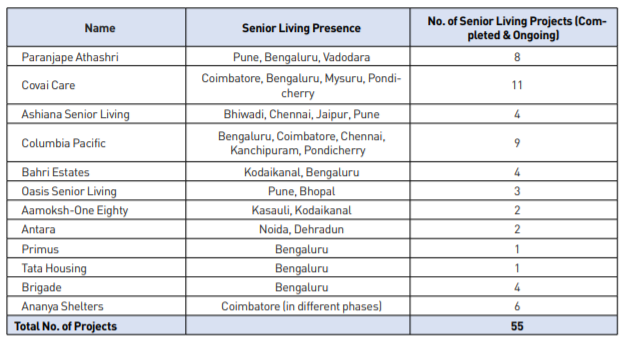Consider these facts
• Top 12 senior living players presently have just 55 ongoing/completed projects – 60% in Tier 2, 40% in Tier 1 cities
• Top developers in this segment include Brigade Enterprises, Paranjpe Schemes, Tata Housing, Ashia n a Housing ; Max India Ltd’s Antara Senior Living recently announced ~INR 300 crore investment over next 4 yrs
• Amidst Covid-19 danger to the aged, more Indian seniors will seek out retirement homes & assisted living facilities on rental and purchase basis
• India’s aged population (>60 years) to touch nearly 173 million by 2026
COVID-19 may reshape the future of the senior living segment in India, with demand for such homes set to zoom up amid the present uncertainties. There is only a limited supply in this segment, via 55 projects by the top 12 players in this segment – 60% in tier 2 cities and the remaining 40% in Tier 1 cities.
Prominent tier 2 cities include Coimbatore, Puducherry, Kodaikanal, Vadodara, Bhopal, Jaipur, Mysuru, Dehradun, Kasauli and Kanchipuram, among others. Key Tier 1 cities are Bengaluru, Chennai, Pune, Noida, etc.
Region-wise, the southern cities have a nearly 69% share of these projects, coinciding with the demographic assumption that elderly population growth in the Southern states will grow at a faster pace than the rest of India, according to a report by SBI.
The Senior Living Opportunity
The United Nations Population Fund & Help Age India estimate that India’s aged population (>60 years) will touch 173 million by 2026. COVID-19 is likely to accelerate demand for senior living – the pandemic has highlighted the elderly’s need for safety, care, well-being and companionship. As such, this asset class is a significant opportunity for developers and investors.
“Due to the rise of nuclear families, increased life expectancy and people living across geographies, ‹independent seniors› are becoming a new demography. Such seniors do not settle for traditional old-age homes as they prefer – and can afford – autonomy and the company of age peers in well-equipped retirement communities. A recurring theme of this pandemic has been seniors living alone, struggling for basics, managing without house help and anxious about existing and potential medical issues. The need for homes in a setting where these factors are taken care of is now undeniable,” said Anuj Puri, Chairman, ANAROCK
Responding to the rebooted opportunity, Max India Ltd’s Antara Senior Living recently announced ~ INR 300 crore investment over the next 4-5 years, in senior living projects to come up in Delhi-NCR, Mumbai, Pune, Hyderabad, Bengaluru and Chennai.
Senior Living Cities
Senior living projects have sprung up mainly in the outskirts of the major cities and in tier II and III cities across the country. Bhiwadi in NCR, Neral in Mumbai, Talegaon in Pune and Devanahalli in Bengaluru are some of the prominent locations around Tier 1 cities, while tier 2 & 3 cities have more supply – a 60% share in approx. 33 projects. Tier 1 cities have just 22 projects dedicated to seniors.
Among current projects, some are entirely for seniors (>55 years of age) while in others, only certain blocks/ towers have dedicated senior-specific facilities. The latter option allows seniors to live in the same integrated township as their families, but among their age peers.
The Cost of Senior Living
The top players operate on either of two models – outright sale or rentals (with security deposit and monthly charges). Average monthly rentals in senior living residences across cities start as low as INR 30,000 and go up to INR 1 lakh, depending on facilities, type of occupancy, etc. For outright sale, property prices vary depending on the city, facilities on offer, BHK-configuration, size etc. The maximum supply across cities is in the range of INR 20-80 lakh, again depending on various factors. There are also some limited exclusive high-end senior living projects wherein units are priced between INR 2 – 8 Crore.

Source: ANAROCK Research
Current Policy Framework
To safeguard the rights of seniors, the Ministry of Social Justice and Empowerment in India has defined models for operating and monitoring retirement homes. While the framework is based on regulations and guidelines for residential real estate, of which senior living is a part, the norms acknowledge that senior living developments differ from conventional housing and have special requirements.
The planning norms include permissible sizes of units in such projects, permitted FAR and inclusion of such developments within the residential zones of the city’s masterplan. For instance, the average size of 1 BHK dwellings must be at least 40-60 sq. mt. while for 2 BHK at 50-80 sq. mt. in plains. In hilly terrains, a 1 BHK must be 30-35 sq. mt. and 2 BHKs at 40-60 sq. mt. The physical standards must conform to the National Building Code Model and its bye-laws.
With a regulatory body for managing and developing such assets already in place, increased developer activity, the institutionalisation of caregivers and specialised service providers are likely to be the next steps. Institutional capital will follow, as such assets are essentially income yielding depending on the model adopted.























